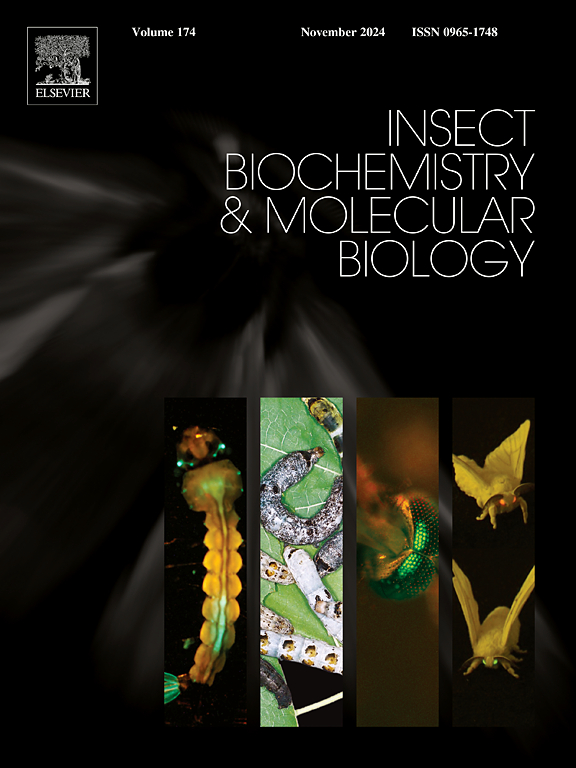秋粘虫ph敏感氯离子通道的鉴定及药理特性研究。
IF 3.2
2区 农林科学
Q2 BIOCHEMISTRY & MOLECULAR BIOLOGY
引用次数: 0
摘要
ph敏感氯离子通道(phcl)是无脊椎动物独有的,在流体调节、食物选择和摄入中起着至关重要的作用。在这项研究中,我们从秋粘虫Spodoptera frugiperda中鉴定并分离了两个编码SfpHCl1和SfpHCl2亚基的cdna。两个亚基表现出相似的表达模式。当在非洲爪蟾卵母细胞中表达时,SfpHCl1和SfpHCl2形成了具有氯离子选择性的功能氯离子通道。细胞外pH值从酸性到碱性的变化诱导SfpHCl1和SfpHCl2向内电流,EC50值分别为8.24和8.49。锌离子(Zn2 +)和杀虫剂苯甲酸埃维菌素(EB)也激活了这些通道中浓度依赖性的内向电流,无论是单独表达还是共表达。值得注意的是,SfpHCl1和SfpHCl2通道的激活和失活时间常数存在显著差异。分子对接模拟表明,Zn2 +通过三个氢键与SfpHCl1和SfpHCl2结合,而EB通过氢键和盐桥与这些通道相互作用。这些发现阐明了ph敏感的锌门控氯离子通道的生物物理和药理学特征,该通道仅存在于无脊椎动物中,为开发高特异性杀虫剂提供了一个有希望的靶点。本文章由计算机程序翻译,如有差异,请以英文原文为准。

Identification and pharmacological characterization of pH-sensitive chloride channels in the fall armyworm, Spodoptera frugiperda
The pH-sensitive chloride channels (pHCls) are unique to invertebrates and play crucial roles in fluid regulation, food selection, and intake. In this study, we identified and isolated two cDNAs encoding the SfpHCl1 and SfpHCl2 subunits from the fall armyworm, Spodoptera frugiperda. Both subunits exhibited similar expression patterns. When expressed in Xenopus laevis oocytes, SfpHCl1 and SfpHCl2 formed functional chloride channels with reversal potentials indicative of chloride selectivity. Shifts in extracellular pH from acidic to alkaline conditions induced inward currents in both SfpHCl1 and SfpHCl2, with EC50 values of pH 8.24 and 8.49, respectively. Zinc ions (Zn2⁺) and the insecticide emamectin benzoate (EB) also activated concentration-dependent inward currents in these channels, whether expressed individually or co-expressed. Notably, SfpHCl1 and SfpHCl2 channels exhibited significant differences in their activation and deactivation time constants. These findings elucidate the biophysical and pharmacological characteristics of pH-sensitive, zinc-gated chloride channels, which, being exclusive to invertebrates, present a promising target for the development of highly specific insecticides.
求助全文
通过发布文献求助,成功后即可免费获取论文全文。
去求助
来源期刊
CiteScore
7.40
自引率
5.30%
发文量
105
审稿时长
40 days
期刊介绍:
This international journal publishes original contributions and mini-reviews in the fields of insect biochemistry and insect molecular biology. Main areas of interest are neurochemistry, hormone and pheromone biochemistry, enzymes and metabolism, hormone action and gene regulation, gene characterization and structure, pharmacology, immunology and cell and tissue culture. Papers on the biochemistry and molecular biology of other groups of arthropods are published if of general interest to the readership. Technique papers will be considered for publication if they significantly advance the field of insect biochemistry and molecular biology in the opinion of the Editors and Editorial Board.

 求助内容:
求助内容: 应助结果提醒方式:
应助结果提醒方式:


